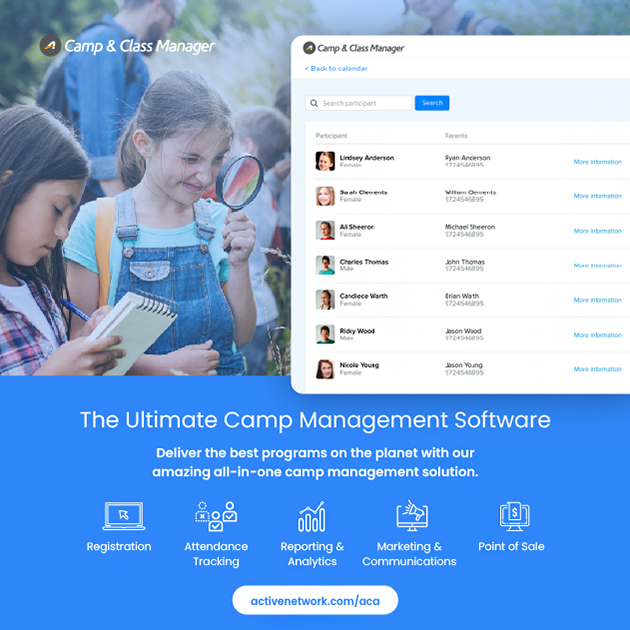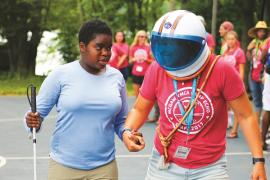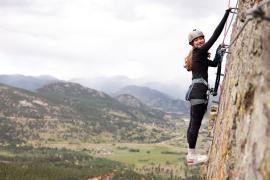If you’re reading this Conference Preview issue of Camping Magazine, you’re probably (like me) getting excited about the ACA National Conference. You’re eagerly anticipating some insightful educational sessions and even an eye-opening chat with a vendor or two. Also, if you’re like me, you might be looking at these opportunities from the perspective of your organization: who’s got an innovative idea to help with our sticky staffing situation? Who’ll offer us a new tool to help crack this tough program problem we’ve been avoiding? Have you, too, come home from past national conferences with a notebook full of new ideas, then dusted off that notebook the following September only to realize you never quite found the time to make some (or any?) of them happen?
Make 2022 the year that you will implement all your great national conference ideas. Easy, right? Well, if past years have proven anything, making your best ideas happen will not be so easy. Maybe you need to shift your business model so you can start paying your counselors more (and thus hire better-quality staff). Or maybe you need to take a deep, hard look at your camp’s inclusion efforts so you can equitably increase the diversity of your campers. Ideas like these aren’t easy because they’re strategic, cultural, or organizational. You can’t just put them on your to-do list; you have to change your camp’s strategy, culture, or organization to make them a reality.
So, why is culture change so hard? Sometimes we simply don’t have the authority within our organization to make change happen in a frictionless way (more on that later). But even if you’re your camp’s CEO/owner/board president, change is difficult. That’s because the story you’re telling about this change to yourself or to others may not be the story your people are hearing or telling themselves — or it just isn’t a story that’s meaningful to them. Step one of change management is to listen empathetically and vulnerably.
Listen for the Pain Points
In the face of change, people often get armored and defensive, because change is frequently associated with loss. For me, the hardest part of the COVID pandemic wasn’t a fear of personally getting sick, but a loss of relationships, routine, and control. This happens on a micro, noncrisis level too. Your effort to remove Indigenous cultural appropriation from your camp might be perceived as a loss of pride. (“What will I do with all my old camp shirts with the teepee on them?”) Switching to an innovative new registration system could negatively impact your people’s sense of their expertise. (“I knew everything about our old system, and now I have to start from scratch?”) Whatever the change is, it can also hit people as a loss of valuable time — just one more thing to add to their to-do list. So exercise some perspective-taking and figure out the pain points before you craft an inclusive narrative of your change.
Plan Your Narrative
Once you’ve got a sense of your group’s current attitudes, you can begin to plan an inclusive change narrative, one that fits your organization. Lean into your organization’s purpose and use that as a frame. Your “purpose” might be your mission statement, but that’s not always something you can truly tap into to drive change. I prefer Jim Collins’s “Hedgehog Concept,” the Venn diagram intersection of what you’re deeply passionate about, what you can be the best in the world at, and what drives your economic engine (Collins, 2001). Sometimes (if you’re lucky), that is your mission statement, but I find that the Hedgehog Concept’s focus on passion and excellence is a truer picture of an organization. Once you’ve found your hedgehog, you can use it to frame your change narrative. When my camp considered whether to open for summer camp 2020, we thought about it through the lens of our purpose: could we still achieve our hedgehog of building happy people through exceptional camp experiences with all the changes required by COVID? (Yes, we could, and we did!)
Mine your organization’s stakeholders for influencers and cheerleaders who can champion your change narrative. Think broadly about stakeholders, including both the folks on your team and “outsiders” like smart board members, trusted camp parents, and thoughtful alumni. Start with the people whose opinions truly matter to you, not just your “yes” team. Brene Brown calls this your “Square Squad” (Brown, 2018), because you should edit your list down to those who fit in a one-inch square. When I have a hefty change to instigate, I always start with one of our camp directors. Not only can I trust him to call out my dumb ideas and help refocus my mediocre ones, but I know that if I can get him on board with a change, he’ll bring along most of my staff. He speaks “counselor” and reframes my change narrative for our staff better than I ever could.
Review Before You Implement
The final step of planning your change is to operationalize it. Having a clear pathway, broken down into measurable chunks, helps you get to your end goal. It keeps you on track if you get distracted by all the other stuff you do each spring. Lots of organizations will do a debrief, after-action review, or “postmortem” after a big project (particularly if it fails). Instead, flip the order around and get your team together for a before-action review (Darling et al., 2005). With your camp’s purpose and your desired change in mind, ask yourselves four questions:
- What’s our intended result, and how do we know/measure if we got there?
- What challenges can we anticipate?
- What have we or others learned from similar situations?
- What will make us successful this time?
From that conversation, take your change from a big idea down to a concrete, measurable action plan with tasks, assignments, and timetables. That feels more manageable than “hire more male staff,” right?
Launch
Now that you have a purpose-driven change narrative and an action plan, just do it. The biggest hurdle to real, lasting change is inertia. It’s easier to do the same thing you’ve always done than to do things differently. Reach out to trusted colleagues (your Square Squad) and get a pep talk. Then take a deep breath and a step forward.
Practice Transparency
Communicate the new change bravely to all your stakeholders (again, that includes everyone impacted by your change, from campers and parents to counselors and board members). Be clear about what the change is, why it’s important, and how you’re getting there. Be timely: communicate as much as you know, whenever you know it. Most importantly, be transparent about uncertainty. From my perspective, camps that stumbled in their COVID reopening did so because they weren’t upfront about uncertainty, not because they did anything wrong protocol wise. Prior to June 2020, literally no one had run a summer camp during a global pandemic; the camps that vulnerably communicated this fact built the trust needed to implement whatever changes were required.
Couple this vulnerability with the grounded confidence that comes from leaning in to your camp’s purpose and values. The Buddhist teacher Roshi Joan Halifax calls this “strong back, soft front” (Brown, 2017). When my camp shared our decision to change our 67-year-old logo that featured a culturally inaccurate teepee and to stop naming our groups after Indigenous tribes, we talked a lot about our thought process and how our values of respect and belonging informed this change. We made it clear, too, that while we were there to discuss why we’d done this, we weren’t open to debate or persuasion.
Be a Team
By now, you should have most of your people on board with your change, moving forward together. What to do, then, if you have a malcontent stuck in the inertia of their old ways, naysaying your big change to others? Having the right people is the most important part of making change stick, so it might be time to move on without that individual. In BE 2.0, Collins offers a great framework for deciding whether it’s time to replace someone, and my favorite part of this is to ask whether your naysayer has a values problem, a skills problem, or a will problem. If someone’s values don’t align with your camp’s, it’s an easy call to replace them. If someone just can’t figure out how to make the change, it’s an easy move to teach them the skills they need to catch up with your change. “The hardest call comes with the question of will,” say Collins and coauthor William Lazier. “Does the person lack (or has the person lost) the will to develop . . . ? If not, can you ignite their will? Great leaders never underestimate how much people can grow, but they also know that growth depends on the humility and relentless will to improve” (Collins & Lazier, 2020).
Make Changes as Needed
Finally, learn together and iterate when you need to. Michael Brandwein always says, “I can’t do that . . . yet.” Camp is the best place to do hard things together. Stick to your action plan, but continue listening empathetically to the folks around you. Make changes to your change as needed. If you have one end goal in mind, remember that there are potentially infinite ways to get there. When COVID forced my camp to shift from bus transportation (how we’d done it for 67 years) to parent drop-off, we had a clear plan prior to the summer of how to do this. Of course, Day 1 showed us things we could do better, so we tried those for Day 2. By Week 2, we had learned new ways to make it easier for parents and counselors, so we made those things happen. And by Week 3, things were moving pretty smoothly. We knew that “get campers to and from camp safely and efficiently” was our end goal, and the Day 1 plan was just a rough draft. By constantly interrogating and tweaking the plan, we achieved that goal.
So what if you’re not the head honcho/executive director/unanswerable camp dictator? Reporting to an owner or board might give you less autonomy to implement change, but you can still follow this framework. Leadership buy-in is incredibly important to enacting and sustaining change, so listen for their fears of loss, and speak to those directly in crafting your change narrative. Maybe they just need a clear business case (“Paying our counselors more will increase costs by X, but having better counselors will increase our camper retention by Y, leading to a Z increase in revenue.”). Tap into their ownership of the camp’s purpose and involve them in your planning. They’ll come along with you.
Is this easy? Of course not. But your change is worth it. Put the work in. It’ll feel better than finding that unread “Ideas from ACA National Conference” list six months from now!
Photo courtesy of Camp Spearhead, Marietta, SC.
Andy Kimmelman is the co-owner and director of Tumbleweed Day Camp in Los Angeles and a Society for Human Resource Management Senior Certified Professional. He’s also an avid volunteer with ACA, serving as the chair of the Southern California/Hawaii Local Council of Leaders and an accreditation visitor, among other roles. Most importantly, he’s a cool dad.
References
Brown, B. (2017). Braving the wilderness. New York, NY: Random House.
Brown, B. (2018). Dare to lead. New York, NY: Random House.
Collins, J. (2001). Good to great: Why some companies make the leap and others don’t. New York, NY: HarperCollins.
Collins, J., & Lazier, W. (2020). BE 2.0. New York, NY: Portfolio/Penguin.
Darling, M., Parry, C., & Moore, J. (2005, July-August). Learning in the thick of it. Harvard Business Review. hbr.org/2005/07/learning-in-the-thick-of-it





